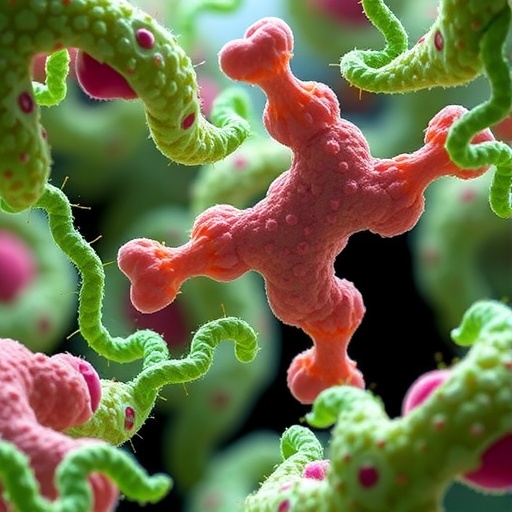In a groundbreaking study that shifts the fundamentals of bacterial outer membrane protein (OMP) assembly, researchers have unveiled novel insights into the machinery of the Bacteroidota phylum, informed by meticulous genetic manipulation and structural biology. The focus of this research was on the BAM complex—a critical facilitator for integrating OMPs into the outer membrane—specifically dissecting the roles of the BamG and BamH subunits within Flavobacterium johnsoniae. These findings illuminate the nuanced mechanics behind OMP biogenesis, uncovering potential client-specific dependencies that challenge previous generalized assumptions about BAM complex function.
The research addressed a central mystery: why are the BamG and BamH subunits indispensable for BAM functionality in F. johnsoniae, a trait diverging markedly from the canonical understanding of BAM complexes in model organisms like Escherichia coli? While the apparent phenotype suggested a direct universal role in outer membrane protein biogenesis, deeper investigation revealed that their importance might be tied to the proper handling of specific subsets of BAM clients. The inability to detect additional trapped BAM substrates in BamG or BamH-depleted strains pointed to an indirect mechanism, possibly an accumulation-induced interference on BamA, the core BAM component.
By isolating and characterizing spontaneous suppressor mutants, the researchers identified a critical point mutation, Q801K, in the BamA subunit that remarkably compensated for the absence of BamH. This substitution was sufficient to restore growth to wild-type levels even when both bamH and its genetic paralogue bamH2 were deleted, thereby rendering BamH non-essential under these artificially modified genetic contexts. This finding not only underscores the exquisite adaptability of the BAM complex but also establishes a cornerstone for understanding functional redundancies within bacterial membrane assembly machinery.
Notably, this suppressor mutation did not alleviate the essentiality of BamG, providing compelling evidence that BamH and BamG perform non-overlapping roles within the BAM complex. The functional specialization of these subunits appears intricate, with BamH potentially tailored for a subset of OMP clients, as highlighted by the observation that strongly expressed SusCD and SusE proteins—key components of the starch utilization system (SUS)—were restored to wild-type levels in the bamH suppressor mutant.
Electron microscopy investigations demonstrated near-normal cellular morphology in bamH suppressor mutants, free from the outer membrane integrity compromises or motility defects often associated with BAM component disruptions. The lack of aberrant phenotypes confirmed the suppressor mutation’s profound restorative capacity and provided a functional window into the specific client-dependent aspects of BAM-mediated OMP assembly.
Further proteomic profiling of the outer membrane revealed a heterogeneous recovery of OMP populations upon BamH depletion and subsequent suppression. While general levels of many outer membrane proteins returned to baseline, certain proteins—predominantly SusCD pairs and their S-layer protein (SLP) partners—remained significantly underrepresented. This implies a selective sensitivity, wherein BamH is particularly pivotal for the biogenesis of a distinct subset of the SUS system components.
The implications of this research extend beyond the molecular intricacies of Flavobacterium johnsoniae, suggesting a more complex, possibly client-specific, assembly paradigm for BAM complexes across Bacteroidota, a diverse bacterial phylum with ecological and biomedical significance. Understanding these mechanisms offers profound insights into bacterial adaptability, membrane biogenesis, and potentially, antibacterial target development.
The genetic suppressor screens employed elegantly bypass the lethality of critical BAM component deletions, enabling a dissection of protein-protein interactions and functional dependencies within the complex. This approach mirrors previously reported systems in E. coli, where BamD deletion viability was similarly unlocked through bamA suppressor mutations, highlighting a recurring evolutionary strategy within bacterial membrane assembly systems.
High-resolution analyses of the outer membrane architecture, including the size comparison between BAM complexes and other well-characterized systems such as the SusCD complex and OmpA, contextualize these findings within the broader framework of membrane protein biogenesis. The BAM complex’s unique assembly demands and its intricate interplay with specialized chaperones underscore potential vulnerabilities exploitable in antimicrobial strategies.
Critically, this study not only challenges the dogma equating BAM subunits with uniformly essential roles but also pioneers a nuanced view recognizing client specificity and genetic contextuality. This paradigm shift calls for further mechanistic investigations and may redefine how microbiologists conceptualize bacterial outer membrane biogenesis and its manipulation.
The restored function of the SUS system in bamH suppressor mutants, despite BamH absence, suggests therapeutic opportunities—manipulating suppressor pathways to modulate bacterial outer membrane composition. Such strategies could attenuate pathogen virulence or influence microbiome dynamics by targeting conserved yet adaptable protein assembly pathways.
In conclusion, this comprehensive analysis of bamH suppressor mutants enriches our comprehension of bacterial outer membrane biogenesis. The discovery of a bamA point mutation mitigating bamH deletion phenotypes opens a new frontier in understanding BAM complex plasticity and client-specific assembly requirements. It invites researchers to reconsider canonical models and to explore the evolutionary adaptability of bacterial membrane systems.
These findings set the stage for new explorations in microbial physiology and may inform innovative antimicrobial designs that exploit the differential dependencies of BAM subunits. As we deepen our molecular understanding of BAM complex function, the potential for impactful translational applications becomes increasingly tangible, highlighting the significance of this research within bacteriology and beyond.
Subject of Research: Outer membrane protein biogenesis machinery in Bacteroidota, focusing on the roles of BamG and BamH subunits within the BAM complex of Flavobacterium johnsoniae.
Article Title: A new paradigm for outer membrane protein biogenesis in the Bacteroidota.
Article References:
Liu, X., Orenday Tapia, L., Deme, J.C. et al. A new paradigm for outer membrane protein biogenesis in the Bacteroidota. Nature (2025). https://doi.org/10.1038/s41586-025-09532-8
Image Credits: AI Generated
Tags: bacterial membrane protein functionalityBacteroidota protein biogenesisBAM complex in bacteriaBamG and BamH subunitsEscherichia coli comparisonFlavobacterium johnsoniae researchgenetic manipulation in microbiologymutations in BAM complexOMP client-specific dependenciesouter membrane protein assemblyprotein biogenesis mechanismsstructural biology of bacteria





